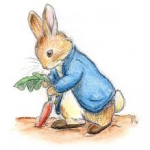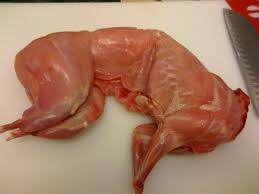As my husband can attest, I am not an everyday cook, but I do enjoy cooking for a special occasion. But then Nick wonders why I experiment on dinner guests. My answer is that my cooking is a “one and done” event. It is similar to my knitting. I can always find a way to improve an afghan, but once completed, I am so sick of the project that it wouldn’t occur to me to repeat it. This brings me to my first experiment with rabbit. It was over 30 years ago, and this was our debut dinner party as a married couple. I decided that the usual quartet of main course options – red meat, chicken, pork or seafood – was too mundane, and selected rabbit as a novelty entrée. I special ordered some rabbit from the butcher and got a recipe from Helen, who lives in Paris. I put all of the rabbit into the pot and simmered it with a cream and mustard sauce. I then served it with a side dish of cranberries.
A total disaster. I did not realize that the butcher gave me every single bit of rabbit. I had just dumped everything into the stew pot. Unfortunately, some of the pieces were basically pure bones – like the rabbit neck. Furthermore, the business ends of the rabbit, i.e. the hind legs, were significantly undercooked – in fact, Nick swore that they were raw. There was an uncomfortable silence as my dinner guests tried to either find the meat, or contemplate eating raw meat. The only sound was the little clink of knives slipping off the bones and hitting the plate. The cranberry situation was a failure as well– the dish was so sweet that it should have been a dessert served with a scoop of ice cream. Everyone was too polite to say anything as we gamely tried to make our way through the meal, but I would like to belatedly apologize – sorry Robert, Anne, Sandy, Charlie, Sallie and Jay.
I gave up on rabbit for about 15 years, but then I had the opportunity to experience authentic rabbit at a French restaurant as guests of our Francophile neighbors the Reeds. I thought that I would be very simpatico by ordering the classic French dish, so when the waiter turned to me I said, “Lapin, s’il vous plaît.” I looked up beaming and was startled to see the horrified looks of all the Reeds. I had forgotten that Mr. Reed’s passion for the anything French was only surpassed by his passion for rabbits as a backyard delight. In fact, Mr. Reed was utterly besotted with rabbits. His childhood stuffed rabbits were still an integral part of his life, and his son Peter was named after Peter Rabbit. Mrs. Reed said, “You’re kidding aren’t you?” Her tone made it clear that it would be blasphemous to contribute to the death of a rabbit. I quickly changed my order.
Another 10 years passed, and we were traveling in Southwest France with our friends Henry and Lele. We were staying in a rented farmhouse and thus were doing our own cooking. Packaged rabbit was front and center at the supermarket, right at home between the chicken and pork. I insisted that we try rabbit again, and Henry and Nick barbecued it with great success. In France, rabbit is such a routine part of the French diet. Why is there such an American taboo on commercial rabbit? Rabbits should be an economical source of protein. They are renowned for their reproductive capacity and in fact during WWII, the US government encouraged people to raise rabbits to ease the meat shortage, but rabbit has never caught on.
One likely explanation is that outside of rural areas where hunting is part of the culture, rabbits are considered pets. In fact, once you start referring to rabbits as “bunnies,” it becomes increasingly difficult to eat them. In the United States (but not in France) Easter is also closely associated with the Easter Bunny, a gentle soul who brings treats to children. Then of course, we have lovable rabbits in stories and cartoons. The Tale of Peter Rabbit, by Beatrix Potter, is described as the best-selling children’s book in the world, with some 151 million copies in 35 different languages. Peter Rabbit is an anthropomorphic creature who stands fully upright and wears a little blue blazer, but no pants – perhaps it was too difficult to figure out how to discretely tuck in the cotton tail. However, his sisters, Flopsy, Mopsy and Cottontail are more modestly dressed in long skirts. The rabbits live together in an underground hole that comes equipped with a full kitchen, tables and chairs and pots of tea.
Rabbit, by Beatrix Potter, is described as the best-selling children’s book in the world, with some 151 million copies in 35 different languages. Peter Rabbit is an anthropomorphic creature who stands fully upright and wears a little blue blazer, but no pants – perhaps it was too difficult to figure out how to discretely tuck in the cotton tail. However, his sisters, Flopsy, Mopsy and Cottontail are more modestly dressed in long skirts. The rabbits live together in an underground hole that comes equipped with a full kitchen, tables and chairs and pots of tea.
Bugs Bunny was introduced in 1938, and unlike Peter Rabbit, Bugs is “naked,” and he clearly  walks and runs instead of hopping. Bugs is a wise-cracking and sarcastic creature who lives to torture the hapless Elmer Fudd, a fat bald bumbler with a speech impediment – “I’m going to get you, you cwazy wabbit.” Even though the plot line focuses Elmer’s attempts to kill Bugs, I ended up rooting for the guy. Elmer was always the victim of the routine violence that was typical of many early cartoons.
walks and runs instead of hopping. Bugs is a wise-cracking and sarcastic creature who lives to torture the hapless Elmer Fudd, a fat bald bumbler with a speech impediment – “I’m going to get you, you cwazy wabbit.” Even though the plot line focuses Elmer’s attempts to kill Bugs, I ended up rooting for the guy. Elmer was always the victim of the routine violence that was typical of many early cartoons.
A gruesome example of the “rabbit as pet” taboo unfolds in an episode in the Michael Moore movie “Roger and Me.” Michael Moore profiles the decline of Flint, Michigan due to the ailing auto industry, symbolized by Roger Smith, the chairman of General Motors. The filmmaker spots a lawn sign advertising rabbits for sale and stops by for an interview. A pleasant young woman stands cuddling a lush brown rabbit. When Michael Moore asks the woman what she is going to do with the rabbit, she nuzzles the rabbit even more closely, rubs noses with him and then cheerfully announces, “I am going to kill him and put him on our supper table.” Behind her, large dogs aggressively bark and strain at a chain link fence, adding to the sudden menacing turn of events. In the next scene, the woman puts the fluffy bunny on the ground and then we hear a sickening metallic thud as she clubs it. She then hangs the bunny upside down on a tree limb and quickly skins it, in a move that looks like she is peeling off a sweater. With a quick cut up the gut, she eviscerates the bunny and announces that it is ready for the stew pot. It is all very abrupt for us suburbanites who are far removed from a backyard slaughter house, particularly when we see a warm cuddler turn to slaughterer within a matter of minutes. (See youtube clip at: http://www.youtube.com/watch?v=d3gvHWf7ldY)
Another contribution to the rabbit taboo is a general discomfort in eating rodents. If you are eating a rabbit, you may be on a slippery slope, just a hop, skip and a jump away from eating squirrels, another backyard friend. Of course in South American, guinea pig is a routine part of the diet, and in China, almost anything is fair game, even rats. The Bible contributes to the taboo, classifying meats as either clean or dirty. Leviticus 11 describes the dietary restrictions as follows:
The LORD said to Moses and Aaron, “Say to the Israelites: ‘Of all the animals that live on land, these are the ones you may eat: You may eat any animal that has a divided hoof and that chews the cud.
“There are some that only chew the cud or only have a divided hoof, but you must not eat them. The camel, though it chews the cud, does not have a divided hoof; it is ceremonially unclean for you. The hyrax, though it chews the cud, does not have a divided hoof; it is unclean for you. The rabbit, though it chews the cud, does not have a divided hoof; it is unclean for you. And the pig, though it has a divided hoof, does not chew the cud; it is unclean for you. You must not eat their meat or touch their carcasses; they are unclean for you.”
Although this classification seems entirely arbitrary, it may have been originally related to health concerns due to unrefrigerated meat. However, fortunately for farmers, sheep and cattle are on the menu. The hoofless rabbit is theoretically off limits, but considering the widespread consumption of the unclean pig, it seems that many no longer take Leviticus to heart.
All in all, American squeamishness to rabbits seems ill-founded. After all, we are enthusiastic lamb eaters, another tender and innocent creature that is part of the Easter tradition. Modern refrigeration has solved the dietary restrictions based on health. Perhaps the most troublesome issue is that the rabbit is usually packaged as an entire recognizable rabbit that looks a bit like road kill. As cute as lambs may be, once they are butchered and sold as riblets or legs, it no longer evokes the same emotional response.
However, based on our successful grilling in France, I was ready to put my finger in the socket one last time and serve up some rabbit for dinner. The event was a gathering of friends to brainstorm possible plot lines for a murder mystery. I thought that serving a “mystery meat” would be consistent with the overall theme. I picked out a recipe for butterflied leg of rabbit stuffed with a walnut herb paste and then simmered in Proseco wine along with red onions, dried cherries and apricots. The first dilemma was to decide what the recipe meant by rabbit “legs.” Does each rabbit have 4 legs or are the front two limbs really called paws? How many rabbits would I need for 10 people? I ended up getting 5 rabbits and was appalled at the price. Filet mignon would have been much cheaper, but now I was in too far. While the rear legs are fairly meaty, there are also petit rabbit riblets, and then little strips along the spine, i.e. the loins. Nick agreed to cook these additional cuts on the grill, trying to recreate our successful French experience.
I didn’t want to make the same mistake of 30 years ago, so I made sure that I simmered the concoction the full 90 minutes. By this time the trussed legs had shrunken and looked like grey, shaggy wads slithering around amongst the onions. Not a great visual experience, but from the taste bud perspective, I thought that it was damn good. Our dinner guests, although somewhat trepidatious, managed to clean their plates. However, the flavor was entirely due to the onions, cherries and apricots. The rabbit itself contributed little, and I could have made the same recipe with chicken with the same effect. But maybe that is the essence of French cooking. It is all about the sauce. For now, my dalliance with rabbit is officially over. Frog legs anyone?
The missing words in the following poem are anagrams (i.e. share the same letters like spot, stop, post) and the number of asterisks indicate the number of letters. One of the missing words will rhyme with the previous or following line. Your job is to solve the missing words based on the above rule and context of the poem. Scroll down for answers.
Of all animals, both fish, bird and *****
Why do French like rabbits the most and Americans the least?
Is it because we like Bugs who always ***** Elmer Fudd when he’s hunting for food
Or do we shudder at the thought of Peter Rabbit being cooked and stewed.
Unfortunately this concept of bunnies as pets ***** this unfortunate habit
Too bad, since we are denying ourselves the tasty treat of cwazy wabbit.
But if you first ***** it slowly; then add a sweet sauce to make it complete,
You will dazzle your guests with the ideal mystery meat.
*
*
*
*
*
*
*
*
Beast, beats, abets, baste
Follow Liza Blue on:Share:


